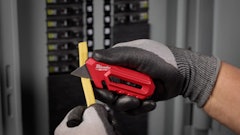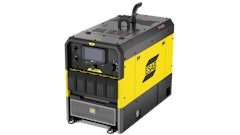While the life cycle of an industrial air compressor typically exceeds 10 years, proper maintenance is crucial to maintaining performance and efficiency. As with most plant systems, planned preventive maintenance is key to keeping air compressors in top condition. While the entire system including clean air treatment equipment, receivers and consumables should be inspected at least twice per year, the compressor is the heart of the system and with a few simple checks can be easily maintained. Plan preventive maintenance in advance and contract with an experienced air system provider or train in-house personnel through reputable training courses offered by the manufacturer.
Compressors can be divided into seven sub-assemblies: pump or airend, motor, drive train, lubricants, controls, coolers and filters. These sub-assemblies are expensive components, and must be maintained on a regular basis. In addition, the benefits of using genuine filters and maintenance parts, and replacing them when needed should not be underestimated. Any contaminants not trapped in the filters will eventually damage machinery and equipment. Using proper filtration and quality fluids is more cost effective than repairing damaged equipment.
Keep the following checklist as a guide for routine maintenance. Plus, the "Problem / Solution" trouble shooting guide, can help identify areas that need attention.
In addition to component maintenance, attention to proper ventilation, ambient temperature and contaminant levels also goes a long way in avoiding problems in the compressed air system.
Trouble shooting guide
Problem: Compressor is running too hot.
Solution: Clean cooler and check for any airflow restrictions. For water-cooled units, check water flow, pressure and quality. Check the lubricant level and add more lubricant if required. Ensure that the area is properly ventilated and correct excessive ambient temperatures.
Problem: Air pressure at compressor discharge is too low.
Solution: Check valves and repair/ replace as necessary. Verify that the air pressure switch has been set and that control adjustment is according to manufacturer's recommendations. Check inlet filter and separator element for contamination.
Problem: Air pressure at the point of use is too low.
Solution: Check for correct pressure setting on compressor discharge. Adjust if necessary. Check the amount of pressure drop across dryer, filters and piping systems. Compressed air demand may be exceeding current capacity — evaluate system to determine if more compressor capacity is required. Check for airline leaks and inappropriate use first.
Problem: Filter service life is too short.
Solution: Use only genuine OEM parts. Generic filters may not meet performance criteria such as micron rating, contamination capacity and pressure drop. In high dust environments, consider using special prefilters, alternate location or duct inlet and cooling air from clean location.
Problem: Water in air lines.
Solution: Check condensate drains and compressed air dryer for proper operation — clean, repair or replace/upgrade as needed.
Problem: Lubricant in air lines.
Solution: Check air/lubricant separation system; change separator element. Follow manufacturer's recommendations for proper lubricant level to avoid over filling.
Tim Dalton is technical service manager for Kaeser Compressors Inc.
Five steps to save money with maintenance
- Use only genuine OEM parts for maximum service life and equipment efficiency.
- Follow a routine maintenance plan or negotiate a preventive service agreement with a reputable service company.
- Perform a leak survey at least annually. On average, over 35 percent of all air used is wasted to leaks.
- Use synthetic compressor fluids to reduce friction and extend change intervals.
- Even the best maintained equipment has a finite service life or eventually becomes obsolete.
Checklist
Pump or Airend
Piston/Pump
- Check the inlet and discharge valves for sticking due to carbon deposits.
- Check for excessive air through the crank case breather indicating worn piston rings.
- Check for low oil pressure indicating worn bearings.
Recommended Rebuild: 5,000-10,000 hours
Rotary Screw Airend
- Check for mechanical seal leakage.
- Check for inlet valve wear.
- Check for excessive bearing "play."
Recommended Rebuild: 50,000 - 100,000 hours
Motor
- Grease motor bearings with the right type of grease.
- Replace bearings on a conservative schedule.
- Check amp draw to prevent motor overload.
- Ventilate compressor room and limit ambient temperature to increase motor life.
Drive Train
Direct Drive (without permanent alignment components)
- Verify that the direct drive system is perfectly aligned.
- Check frame and mounting block for "settling" which may cause misalignment and coupling damage.
Direct Drive (with permanent alignment components)
- Check coupling annually.
Gear
- Check spray bar for excessive contaminants and plugged orifices.
- Check for wear and "backlash."
- Ensure proper lubrication.
V-Belts
- Check v-belt tension.
- Check wear on v-belt/pulley.
Lubricants
Lubricants cool, seal, lubricate and remove contaminants from a compressor.
- Use proper grade (see manual).
- Drain existing lubricant before refilling.
- Draw routine lubricant samples to determine maximum lubricant life.
- Use synthetic lubricant for maximum service life.
Filters
Air
Any contaminants not trapped in the filter will eventually damage machinery and equipment.
- Use proper micron rating as specified by OEM.
- Check pressure differential and, if necessary, carefully clean according to manufacturer's recommendations.
- Check for worn/damaged seals.
- Check structural integrity.
- Replace after filter has been cleaned two or three times.
Lubricant Filter/Lubricant Separator
- Use only genuine replacement parts.
- Change when maximum pressure differential is reached or at each lubricant change, whichever occurs first.
Coolers
- Check for visible contamination and clean regularly.
- Keep clean and dry.
















